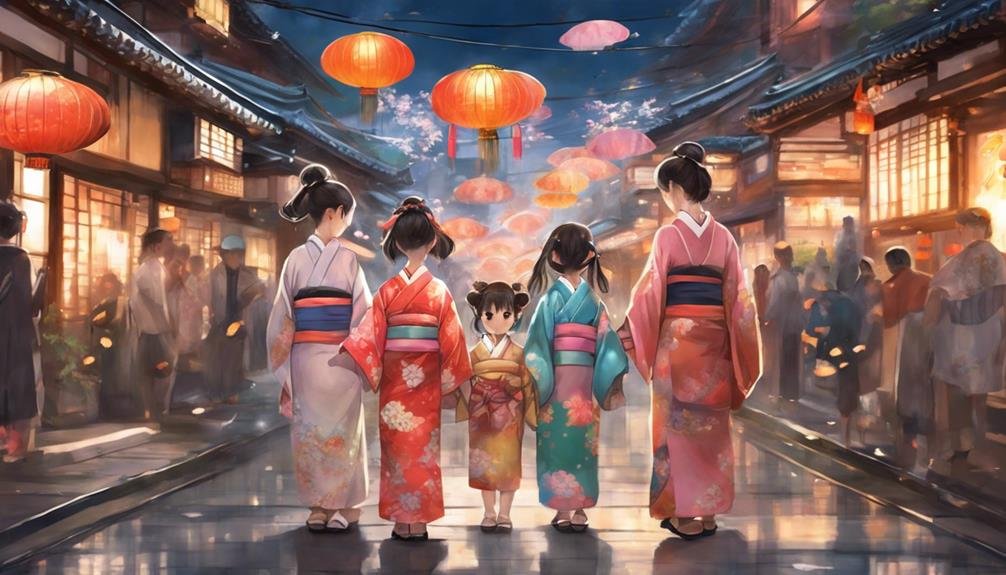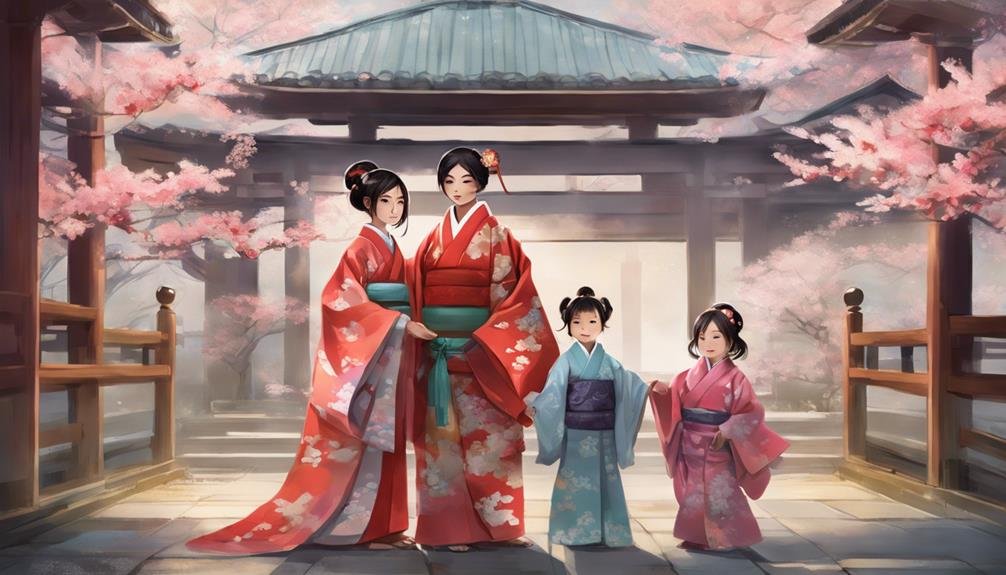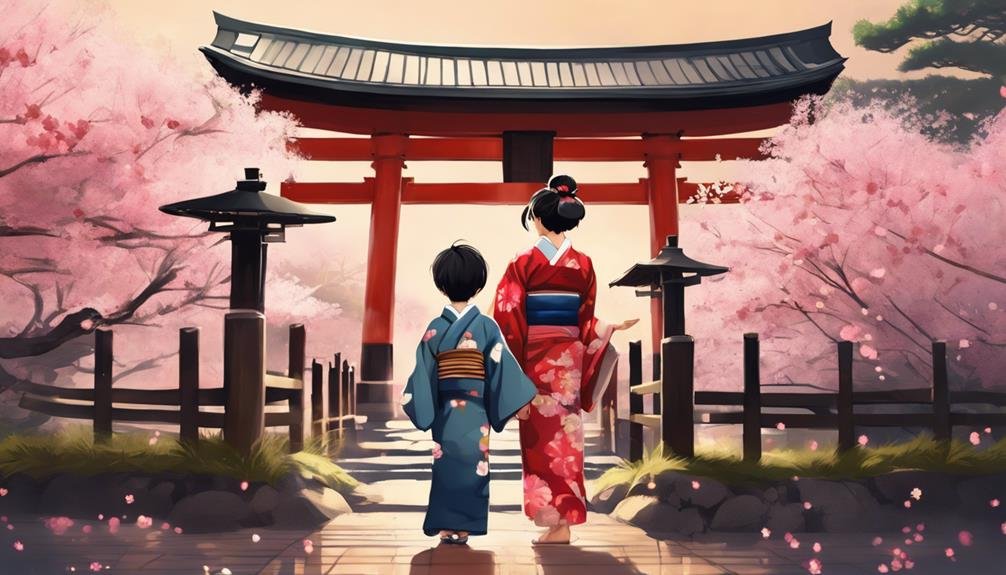Experience Japan’s cultural mosaic with Shichi-Go-San, a beautiful tradition celebrating children’s growth from early to middle childhood. Witness the elegance of kimono attire, rich in symbolism and tradition. Parents seek blessings for their children’s health and prosperity through shrine visits and prayers.
Blend old and new with modern celebrations merging timeless customs with contemporary touches. The essence of family unity and gratitude infuses every aspect of this cherished celebration.
Explore the depths of Shichi-Go-San to discover the intricate details and profound meanings that enrich this cultural milestone.
Key Takeaways
- Shichi-Go-San is a traditional Japanese rite celebrating children’s growth.
- Children aged 3, 5, and 7 mark milestones transitioning to middle childhood.
- Attire includes kimonos with symbolic colours, hakama for boys, and furisode for girls.
- Shrine visits involve prayers for children’s health, prosperity, and family blessings.
- Modern celebrations blend tradition with contemporary elements, preserving cultural heritage.
Origins of Shichi-Go-San
The origins of Shichi-Go-San can be traced back to ancient Japan, where it was a tradition celebrated by noble families to mark the rite of passage for children. This cultural event holds a significant historical background as it was a way to express gratitude for the healthy growth of young ones.
Shichi-Go-San, which translates to ‘Seven-Five-Three’, symbolizes the ages for which children are celebrated – 3, 5, and 7. During this festive tradition, children dress in traditional attire, usually kimono, and visit shrines to pray for their continued well-being and prosperity. The atmosphere is filled with joy and excitement as families come together to capture memorable moments through photographs.
This event not only highlights the cultural significance of family and tradition but also serves as a reminder of the importance of celebrating milestones in a child’s life. The colourful festivities and rituals associated with Shichi-Go-San have evolved over centuries but still retain their essence of honouring children’s growth and health.
Significance of Ages 3, 5, 7
At ages 3, 5, and 7, children in Japan mark important milestones in their growth and development through the traditional celebration of Shichi-Go-San. This cultural tradition holds significant value in Japanese society as it symbolizes the passage from early childhood to middle childhood. Families come together during Shichi-Go-San to honor and celebrate these pivotal ages, showcasing the deep-rooted importance placed on family bonds and generational connections.
The celebration of Shichi-Go-San serves as a time for reflection on the child’s growth and accomplishments while also looking forward to their future development. It’s a moment of joy and pride for parents and relatives as they witness the young ones taking steps towards maturity. The cultural significance lies in the acknowledgment of these specific ages, highlighting the unique stages of a child’s life and the blessings bestowed upon them by their loved ones.
Kimono: Traditional Attire
When it comes to traditional attire in Japan, the kimono holds significant symbolism and cultural importance. Understanding the intricate details of kimono styling can elevate your experience and appreciation for this timeless garment.
From fabric choices to accessories, mastering the art of wearing a kimono can truly enhance your connection to Japanese culture and history.
Kimono Symbolism
Adorned with intricate patterns and vibrant colors, the kimono serves as a symbolic representation of Japanese culture and tradition. The colors and patterns featured on a kimono hold deep meanings, reflecting historical evolution and cultural adaptations. In Japanese culture, each color carries significance; for example, red symbolizes life and essentiality, while white represents purity and new beginnings. Similarly, the patterns adorning kimonos are not merely decorative but hold specific meanings. For instance, cherry blossoms symbolize beauty and the transient nature of life, while waves represent strength and resilience.
To further understand the symbolism behind kimonos, let’s explore the table below:
| Color Significance | Pattern Meanings |
|---|---|
| Red: Life and essentiality | Cherry Blossoms: Beauty |
| White: Purity | Waves: Strength |
| Blue: Serenity | Cranes: Longevity |
| Gold: Wealth | Pine Trees: Endurance |
| Black: Elegance | Butterflies: Transformation |
Through the intricate combination of colors and patterns, kimonos become not just garments but vessels of cultural significance and artistic expression in Japan.
Kimono Styling Tips
Embrace the timeless elegance of kimono styling through thoughtful consideration of color coordination and accessory choices. When selecting colors for your kimono ensemble, opt for harmonious combinations that reflect the season or occasion. For example, soft pastel hues like pale pink or light blue are ideal for spring, while deeper tones such as navy or burgundy exude sophistication in autumn.
Accessories play an important role in enhancing your overall look. Consider adding an obi belt to cinch your waist and create a flattering silhouette. Delicate hair ornaments like kanzashi can add a touch of traditional charm to your hairstyle.
When it comes to hairstyles, a sleek updo or a simple bun can complement the elegance of the kimono. Ensure your footwear, such as zori sandals or geta wooden clogs, matches the formality of your outfit. Whether attending a formal event or a casual gathering, mastering the art of kimono styling will elevate your presence and showcase the beauty of Japanese tradition.
Shrine Visits and Prayers
During the Shichi-Go-San festival in Japan, the tradition of Shrine Visits and Prayers holds a significant place in the hearts of participants, symbolizing reverence and gratitude towards the deities. Prayer rituals play an essential role during these visits, where individuals offer their prayers for the health, happiness, and prosperity of their children.
The act of bowing before entering the shrine, purifying oneself at the chozuya, and offering a monetary donation called ‘saisen’ are all part of the Shrine etiquette observed during these visits.
Shrine visits during Shichi-Go-San also provide a moment for reflection and thanksgiving. Families dressed in their finest attire visit the shrines, seeking blessings and protection for their children as they grow older. The serene atmosphere within the shrines creates a space for contemplation and connection with the spiritual domain.
As the incense wafts through the air and prayers are whispered softly, a sense of peace and unity prevails among the visitors, fostering a deep sense of community and tradition.
Modern Celebrations and Customs

As the Shichi-Go-San festival continues to evolve, modern celebrations and customs reflect a blend of traditional practices and contemporary influences. Nowadays, Shichi-Go-San has adapted to modern trends while keeping its cultural essence alive.
- Incorporation of Technology: Families often capture the special moments of Shichi-Go-San using smartphones and cameras, creating digital memories that can be shared with loved ones worldwide.
- Fashion Fusion: Children don stylish yet traditional outfits, blending classic kimono or hakama with modern accessories to showcase a mix of old and new fashion trends.
- Customized Cuisine: While traditional sweets like chitose-ame remain popular, families now incorporate modern treats and dishes into the celebration, offering a diverse range of foods that appeal to both young and old.
- Contemporary Decor: Festive decorations have evolved to include a mix of traditional items like kimonos and origami with modern elements such as colourful balloons and streamers, creating a vibrant and visually appealing atmosphere for the festivities.
Symbolism in Shichi-Go-San
Where age-old traditions hold deep significance. From the elegant traditional attire to the intricate accessories worn during the celebration. Each element carries a profound meaning that reflects the essence of this cherished event.
Engage with the fascinating world of Shichi-Go-San symbolism to uncover the layers of tradition and cultural heritage woven into this special occasion.
Cultural Meaning of Shichi-Go-San
Delving into the cultural significance of Shichi-Go-San reveals a mosaic of symbolism woven into this traditional Japanese celebration. Shichi-Go-San is more than just a passage of growth; it embodies deep-rooted cultural values and beliefs that have been passed down through generations. Here are some key symbolic elements of Shichi-Go-San:
- Life Shifts: Shichi-Go-San marks a child’s progression from infancy to childhood, emphasizing the importance of milestones in life.
- Ancestral Reverence: By participating in Shichi-Go-San, families honor their ancestors and seek blessings for the children’s future.
- Harmony with Nature: The celebration aligns with the changing seasons, reflecting the balance between humans and the natural world.
- Family Unity: Shichi-Go-San reinforces the significance of family ties and the importance of coming together to celebrate life’s moments.
Through these symbolic layers, Shichi-Go-San transcends mere festivities; it becomes a network of cultural values, family bonds, and spiritual connections that enrich the lives of those who partake in this sacred tradition.
Traditional Attire and Accessories
Traditional attire and accessories in Shichi-Go-San hold profound symbolic meanings that reflect the cultural heritage and values of Japan. When dressing up for this special occasion, every detail from the accessories to the colour coordination has significance. Hair ornaments like the hana kanzashi, and delicate and intricate floral designs, symbolize the beauty and growth of the children celebrating Shichi-Go-San.
The colour coordination in the attire is carefully chosen, with boys often wearing black or navy hakama paired with a kimono and girls donning vibrant and colourful furisode.
The obi styles, whether tied in a butterfly, drum, or taiko knot, convey different messages of prosperity, happiness, and growth in the child’s life. Each element of the traditional attire and accessories is a reflection of the cultural richness and traditions of Japan, making Shichi-Go-San a visually stunning and meaningful celebration.
| Accessories & Hair Ornaments | Color Coordination | Obi Styles |
|---|---|---|
| Hana Kanzashi | Vibrant and colorful furisode | Butterfly knot |
| Tama-Obi | Black or navy hakama with kimono | Drum knot |
| Kanzashi | Symbolic colors for growth and prosperity | Taiko knot |
Continuing the Tradition

To carry on the legacy of Shichi-Go-San in Japan, families meticulously plan and prepare for the annual celebration. This cherished tradition is deeply rooted in Japanese culture, emphasizing the importance of family bonds and cultural heritage. Here’s how families continue the tradition:
- Safeguarding Family Kimonos: Many families pass down heirloom kimonos through generations, symbolizing the continuity of tradition and the beauty of Japanese craftsmanship.
- Incorporating Festive Decorations: Homes and shrines are adorned with symbolic decorations such as chrysanthemum flowers and bamboo leaves, signifying longevity and prosperity.
- Visiting Shrines Together: Families visit Shinto shrines on Shichi-Go-San day, offering prayers for the health and happiness of their children, and creating lasting memories.
- Enjoying Traditional Foods: Special dishes like chitose-ame, long stick candies, and sekihan, red bean rice, are shared amongst family members, celebrating the occasion with culinary delights.
Frequently Asked Questions
Are There Specific Colors or Patterns for the Kimono?
When selecting a kimono, take into account colour symbolism for various occasions. Designs vary from traditional motifs like cranes to modern patterns. Make sure the colours and patterns align with the event’s significance and your style.
How Do Families Prepare for the Shrine Visits?
To prepare for shrine visits, families carefully select gifts and plan hairstyles and accessories. Photography captures the beauty and significance of this tradition. Through these thoughtful gestures, families honour tradition and create lasting memories together.
Is There a Specific Time of Year for Shichi-Go-San Celebrations?
In many cultures, specific seasons mark significant celebrations like Shichi-Go-San. Festive decorations adorn homes, symbolizing cultural significance. The timing of these events varies, aligning with traditions and customs that honour age milestones.
What Are Some Modern Twists on Traditional Customs?
Incorporating contemporary fashion and cultural fusion, modern twists on traditional customs often involve innovative rituals and shifting family dynamics. These updates infuse new life into age-old practices, blending tradition with the present.
Are There Any Special Foods or Treats Associated With Shichi-Go-San?
You’ll find traditional sweets like wagashi, delicate and artfully crafted, symbolizing celebration and sweetness on special occasions. Festive snacks, a fusion of old and new, offer a delightful taste of culture and innovation.
Conclusion
To sum up, Shichi-Go-San is a beautiful and meaningful tradition in Japan that celebrates the growth and well-being of children. The significance of ages 3, 5, and 7, the traditional kimono attire, shrine visits, and prayers all play a part in this special celebration.
As modern customs evolve, the symbolism behind Shichi-Go-San continues to be cherished and passed down through generations, ensuring that this tradition remains a cherished part of Japanese culture.



